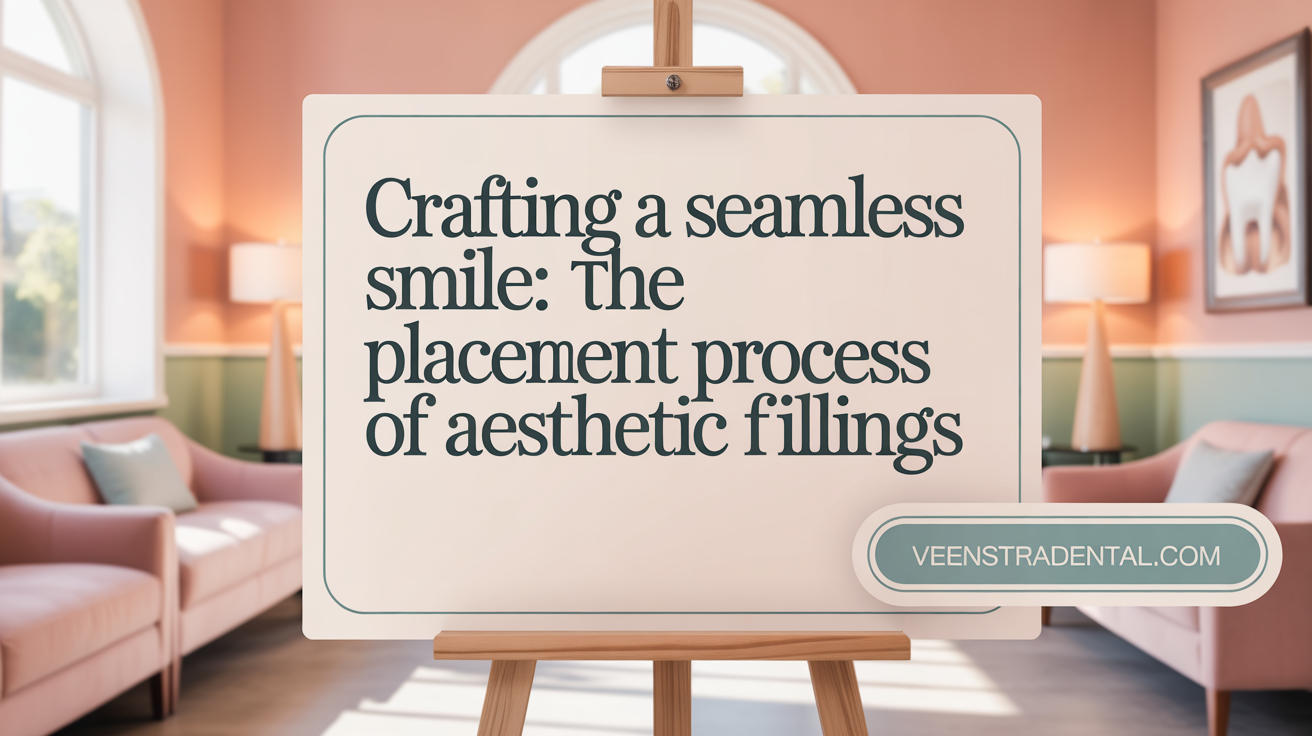Understanding Aesthetic Fillings and Their Natural Integration
Aesthetic dental fillings, particularly composite and tooth-colored options, have revolutionized dental restorations by offering solutions that blend seamlessly with natural teeth. Unlike traditional metallic fillings, aesthetic fillings prioritize the preservation of tooth appearance and structure, providing a natural and virtually invisible repair. This article explores the materials, techniques, and benefits that enable these fillings to harmonize with your smile, enhancing both dental health and confidence.
What Sets Aesthetic Fillings Apart from Traditional Fillings?
What is the difference between aesthetic fillings and normal fillings?
Aesthetic fillings, also called composite resin fillings, are designed to blend seamlessly with your natural teeth. Made from a tooth-colored resin combined with fine glass particles, they match the shade and translucency of enamel. These fillings are bonded directly to the tooth, providing a natural appearance and supporting the tooth's strength.
Traditional fillings, on the other hand, often use metallic materials like amalgam or silver. These metal fillings are visible and do not match the tooth color, making them more noticeable especially in visible areas.
Aesthetic fillings can be placed quickly in a single visit, usually last between 8-10 years, and do not contain mercury, unlike amalgam fillings. They are less invasive, requiring less removal of healthy tooth material, and are suitable for both front and back teeth.
Overall, the main distinction is in the material used and the resulting appearance: aesthetic fillings prioritize a natural, inconspicuous look, whereas traditional metallic fillings focus on durability and cost-effectiveness, but with less emphasis on cosmetic appeal.
Materials and Durability
Aesthetic fillings are made from resin and glass particles that are hardened with a curing light during placement. They are designed to withstand daily chewing forces and have improved significantly in durability thanks to technological advances.
Traditional fillings like amalgam are made from a mixture of metals, which are highly durable and often preferred for their longevity, especially in areas subject to heavy chewing.
Safety and Biocompatibility
Aesthetic fillings are free of mercury and contain biocompatible materials, making them a safe option for most patients. Some individuals with allergies or sensitivities to certain resins may experience reactions, though these are rare.
Metals used in traditional fillings, particularly amalgam, have raised health concerns related to mercury exposure, prompting many to seek mercury-free alternatives.
Visual and Cosmetic Benefits
One of the most notable differences is appearance. Aesthetic fillings are color-matched to the natural teeth, providing a discreet, natural look. They are especially favored for front teeth and visible areas.
Traditional metal fillings are metallic and easily noticeable, which can affect the aesthetics of a smile.
Aesthetic fillings can also be shaped and textured to mimic natural tooth surfaces, enhancing overall dental harmony and boosting confidence.
| Aspect | Aesthetic Fillings | Traditional Fillings | Additional Details |
|---|---|---|---|
| Material | Resin + Glass particles | Amalgam/ Silver | Advanced composites vs. metal alloys |
| Appearance | Tooth-colored, natural | Metallic, conspicuous | Aesthetic priority |
| Bonding | Bonds directly to tooth | Does not bond, relies on cavity shape | Strengthens tooth |
| Durability | 8-10 years, improved with technology | Over 15 years | Longevity depends on location and care |
| Safety | Mercury-free, biocompatible | Contains mercury, potential health concerns | Safety considerations |
| Use Cases | Front/back teeth, cosmetic repairs | Mainly back teeth, heavy stress areas | Versatility |
Search Summary
For more details on how composite and amalgam fillings differ, search for "Differences between composite and amalgam dental fillings."
The Science Behind Composite Fillings: Materials and Color Matching

Composition of composite fillings (resin and glass particles)
Composite dental fillings are crafted from a mixture of resin-based plastics and fine glass particles. The resin, primarily a durable plastic, provides the shape and flexibility needed for a natural look. The glass particles, usually silica or quartz, are added to enhance strength and support the optical properties, allowing the filling to closely match the appearance of natural teeth. This blend creates a material that is both strong enough for biting functions and aesthetically versatile.
How materials mimic natural tooth color and translucency
One of the main advantages of composite fillings is their ability to seamlessly blend with the surrounding teeth. The resin mixture is carefully shade-matched to the patient's natural tooth color. Composition and translucency are critical factors; the glass particles help replicate the natural translucency of enamel, giving the fillings a life-like appearance. This nuanced shading allows the composite to reflect light similarly to natural teeth, making the restoration virtually invisible.
Technological advancements in shade matching
Modern dental technology has significantly improved how dentists select the perfect shade for composite fillings. Digital shade-matching tools, such as spectrophotometers and shade guides, analyze the patient's natural teeth precisely. These devices help in choosing the correct hue, brightness, and translucency, resulting in a more accurate and consistent match. Advanced imaging techniques also assist in capturing color data for customized solutions, elevating the cosmetic outcome.
Role of nanotechnology and bioactive materials
Nanotechnology has revolutionized composite materials by incorporating nanoscale particles that enhance durability and polishability. These tiny particles improve surface smoothness and resistance to staining while maintaining excellent optical properties. Additionally, bioactive materials are being integrated into composites to promote remineralization of the tooth and reduce decay, making restorations not only aesthetic but also protective.
Safety and biocompatibility of composite resin
Composite resins are widely regarded as safe and biocompatible. They have been extensively tested and approved by health authorities for dental use. Typically free of mercury and other harmful metals, the materials pose minimal risk of allergic reactions. Their safety profile makes them suitable for most patients, including those with sensitivities to metals, though rare allergic responses can occur in sensitive individuals.
| Aspect | Details | Additional Notes |
|---|---|---|
| Composition | Resin + glass particles | Combines strength with aesthetics |
| Mimicking natural teeth | Shade matching + translucency | Replicates natural light reflection |
| Technological advancements | Digital shade tools, imaging technology | Improves precision and consistency |
| Nanotech and bioactivity | Nanoparticles, remineralization agents | Enhance durability and health benefits |
| Safety | Mercury-free, tested biocompatibility | Suitable for most patients, low allergy risk |
Through continuous innovations, composite fillings now offer a durable, safe, and highly natural-looking solution that preserves the integrity and beauty of your smile.
Step-by-Step Placement Process of Aesthetic Fillings for a Natural Look

Procedure from decay removal to final polishing
The placement of composite dental fillings begins with the dentist carefully removing any decayed or damaged tissue from the tooth. Once the area is cleaned and prepared, the process moves to the application of the composite material. The dentist first isolates the tooth to prevent moisture contamination, ensuring optimal bonding. Initial steps include etching the tooth surface and applying a bonding agent for adhesion.
Layering and curing with a special light
The composite resin is applied in small, carefully shaped layers. This layering technique not only helps match the natural contour but also enhances the durability of the filling. Each layer is hardened or 'cured' with a high-intensity curing light, which activates the resin's chemical properties, securely bonding it to the tooth. This curing process ensures the filling is solid, stable, and ready for shaping.
Techniques for shaping and texturing to match natural tooth surface
After curing, the dentist shapes the filling to replicate the natural anatomy of the tooth. This involves sculpting the composite to match the surface contours and textures of the surrounding teeth. Good shaping is crucial for functionality—ensuring proper bite alignment—and aesthetics, wishing to create a seamless blend with adjacent teeth. Polishing follows to smooth the surface, giving the restoration a natural sheen that mimics real enamel.
Importance of preserving healthy tooth structure
Modern placement techniques emphasize conserving as much healthy tooth as possible. Unlike older methods, composite fillings require minimal removal of the original tooth tissue, which helps maintain the overall strength and health of the tooth. This conservative approach reduces the risk of future fractures and preserves the natural integrity of the tooth.
Role of experienced dentists in achieving seamless integration
Achieving an invisible, natural-looking result depends heavily on the skill of the dentist. Experienced dental professionals utilize advanced shade-matching tools and meticulous sculpting techniques to ensure the filling blends perfectly. Proper placement, attention to detail, and understanding of tooth anatomy are essential. When done correctly, the composite filling not only restores function but also enhances the appearance by seamlessly matching the surrounding teeth.
How do composite fillings blend in with natural teeth?
Composite fillings blend in with natural teeth by being carefully shaded and sculpted to match the tooth's original color and shape. The resin material contains fine glass particles that can be matched to the natural tooth hue, providing an almost invisible restoration. During placement, the dentist layers and shapes the composite, then cures it with a specialized light, ensuring a seamless integration. Because composite fillings chemically bond to the tooth, they help reinforce the remaining structure and promote a natural appearance. Overall, with proper placement and good oral hygiene, composite fillings offer a durable, aesthetically pleasing, and biocompatible solution that closely resembles natural teeth.
Aesthetic Benefits and Functional Advantages of Composite Fillings

Visual integration enhancing smile appearance
Composite dental fillings are crafted from tooth-colored resin and finely ground glass particles, allowing them to be precisely shade-matched to your natural teeth. This careful color matching ensures that the fillings blend seamlessly, making them virtually invisible. When expertly applied, composite fillings mimic the translucency, texture, and surface contours of your natural teeth, resulting in a harmonious and natural-looking smile. Their ability to replicate the appearance of real enamel makes them particularly popular for restoring front teeth, boosting overall aesthetic appeal.
Reduced sensitivity and thermal insulation properties
Compared to traditional metal fillings, composite options cause less post-treatment sensitivity. This is because composite materials are insulators, meaning they do not conduct temperature changes as strongly as metallic fillings. Consequently, patients often experience less discomfort when consuming hot or cold foods and beverages after placement. This temperature resistance helps protect the tooth’s nerve endings, contributing to a more comfortable recovery.
Durability and lifespan with proper care
Modern composite resins are designed to withstand the forces of biting and chewing. With proper oral hygiene and regular dental checkups, composite fillings can last approximately 7 to 10 years or longer. Advances in technology, such as nanotechnology and bioactive materials, have enhanced their strength and wear resistance, ensuring they remain durable over time. Proper maintenance, including avoiding hard or sticky foods, can help maximize their lifespan.
Preservation of tooth strength via bonding
One of the standout benefits of composite fillings is their ability to bond directly to the tooth structure. This chemical adhesion helps to reinforce the tooth, supporting and strengthening its overall integrity. Unlike amalgam fillings that rely on the shape of the cavity for retention, bonded composite fillings can support the tooth from within, reducing the risk of fracture and preserving more of the natural tooth material.
Versatility in treating cavities and cosmetic corrections
Composite fillings are highly versatile. They can be used to repair small and large cavities, fix chipped or worn teeth, and close small gaps between teeth. Their sculptability allows for precise shaping and contouring, tailoring the restoration to match your natural tooth surface. This flexibility makes composite fillings suitable for both functional repairs and aesthetic enhancements, ensuring that your teeth look and feel natural.
Maintaining the Natural Look of Aesthetic Fillings Over Time

Post-procedure care recommendations
Proper care immediately after getting composite fillings is crucial for maintaining their appearance. Patients should avoid hard, sticky foods that could damage the filling, and maintain good oral hygiene by brushing twice daily and flossing regularly. Regular dental visits allow professionals to monitor the condition of the fillings and keep surrounding teeth healthy.
Avoiding staining and damage
Composite fillings are durable but can stain over time if exposed to stain-causing foods or beverages like coffee, tea, or red wine. Avoiding these can help keep the fillings looking natural longer. Additionally, wearing a mouthguard during sports or nighttime grinding can prevent accidental damage and preserve the integrity of the fillings.
Importance of regular dental checkups and hygiene
Routine dental checkups are essential to inspect the condition of your composite fillings and overall oral health. Dentists can detect early signs of wear, chipping, or staining, and perform necessary repairs. Good oral hygiene habits, including professional cleanings and fluoride treatments, can extend the lifespan of your fillings and prevent decay around the restored areas.
Repairability and longevity of composite fillings
Unlike amalgam restorations, composite fillings can be easily repaired or touched up without removing the entire filling. When properly cared for, these tooth-colored restorations can last 10 years or more, providing a lasting natural appearance. Regular maintenance and avoiding harmful habits can significantly improve their durability.
Impact on long-term dental health and aesthetics
Maintaining the appearance and integrity of composite fillings not only preserves your smile aesthetics but also supports long-term tooth health. Since these fillings bond closely with tooth structure, they help prevent fractures and decay, promoting overall dental stability. Consistent care ensures that your natural-looking restorations continue to enhance your smile for years.
The Seamless Future of Aesthetic Dental Restorations
Aesthetic dental fillings, particularly composite resin types, stand out as an innovative solution that marries functionality with natural appearance. Their ability to blend indistinguishably with your natural teeth through advanced materials and meticulous placement techniques not only restores dental health but also enhances confidence and smile aesthetics. By preserving more of the natural tooth structure and minimizing sensitivity, these fillings offer both cosmetic and health advantages. With proper maintenance, aesthetic fillings can provide lasting beauty and durability, marking a significant evolution in restorative dentistry focused on blending seamlessly with nature.
References
- How Composite Fillings Improve Smile Aesthetics
- Tooth-Colored Fillings: Blending Seamlessly with Your Natural Teeth
- How Dental Fillings Can Improve Your Smile Aesthetics
- How Composite Fillings Blend Seamlessly With Your Natural Teeth
- Tooth-Colored Fillings: Blending Seamlessly with Your Natural Teeth
- The Aesthetic Benefits of Composite Fillings - Sterling Dental Center
- The Art of Dental Filling: Exploring Tooth-Colored Composite Fillings
- Tooth-Colored Fillings: Cavity Filling With Aesthetic Appeal
- Understanding White Fillings: A Modern Dental Solution
- White Composite Dental Fillings - Cosmetic Dentistry
